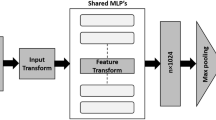Abstract
LiDAR sensors have been very popular in robotics due to their ability to provide accurate range measurements and their robustness to lighting conditions. However, their sensitivity to airborne particles such as dust or fog can lead to perception algorithm failures (e.g., the detection of false obstacles by field robots). In this work, we address this problem by proposing methods to classify airborne particles in LiDAR data. We propose and compare two deep learning approaches, the first is based on voxel-wise classification, while the second is based on point-wise classification. We also study the impact of different combinations of input features extracted from LiDAR data, including the use of multi-echo returns as a classification feature. We evaluate the performance of the proposed methods on a realistic dataset with the presence of fog and dust particles in outdoor scenes. We achieve an F1 score of 94% for the classification of airborne particles in LiDAR point clouds, thereby significantly outperforming the state of the art. We show the practical significance of this work on two real-world use cases: a relative pose estimation task using point cloud matching, and an obstacle detection task. The code and dataset used for this work are available online.
Leo Stanislas and Julian Nubert are equaly contributors
Access this chapter
Tax calculation will be finalised at checkout
Purchases are for personal use only
Similar content being viewed by others
References
Chen, X., Ma, H., Wan, J., Li, B., Xia, T.: Multi-view 3d object detection network for autonomous driving. CoRR (2016)
Darms, M.S., Rybski, P.E., Baker, C., Urmson, C.: Obstacle detection and tracking for the Urban challenge. IEEE Trans. Intell. Transp. Syst. (2009)
Dubé, R., Cramariuc, A., Dugas, D., Nieto, J., Siegwart, R., Cadena, C.: SegMap: 3d segment mapping using data-driven descriptors. Robotics: Science and Systems (RSS) (2018)
Elfes, A.: Using occupancy grids for mobile robot perception and navigation. IEEE Computer (1989)
Geiger, A., Lenz, P., Urtasun, R.: Are we ready for autonomous driving? the kitti vision benchmark suite. In: Conference on Computer Vision and Pattern Recognition (CVPR) (2012)
Gerardo-Castro, M.P., Peynot, T., Ramos, F., Fitch, R.: Non-parametric consistency test for multiple-sensing-modality data fusion. In: IEEE International Conference on Information Fusion (2015)
Laible, S., Khan, Y.N., Bohlmann, K., Zell, A.: 3D LIDAR- and camera-based terrain classification under different lighting conditions. Auton. Mob. Syst. (2012)
Lalonde, J.F., Vandapel, N., Huber, D.F., Hebert, M.: Natural terrain classification using three-dimensional ladar data for ground robot mobility. J. Field Robot. (2006)
Levinson, J., Thrun, S.: Robust vehicle localization in urban environments using probabilistic maps. In: IEEE International Conference on Robotics and Automation (2010)
Montemerlo, M., Jan, B., Suhrid, B., Dahlkamp, H., Dolgov, D., Ettinger, S., Haehnel, D., Hilden, T., Hoffmann, G., Huhnke, B., Johnston, D., Klumpp, S., Langer, D.: Junior: the stanford entry in the Urban challenge. J. Field Robot. (2008)
Motaz Khader, S.C.: An introduction to automotive lidar. Tech. rep, Texas Instruments (2018)
Peynot, T., Kassir, A.: Laser-camera data discrepancies and reliable perception in outdoor robotics. In: IEEE International Conference on Intelligent Robots and Systems (2010)
Peynot, T., Scheding, S., Terho, S.: The marulan data sets: multi-sensor perception in natural environment with challenging conditions. Int. J Robot. Res. (2010)
Phillips, T.G., Guenther, N., McAree, P.R.: When the dust settles: the four behaviors of lidar in the presence of fine airborne particulates. J. Field Robot. (2017)
Qi, C.R., Su, H., Mo, K., Guibas, L.J.: Pointnet: Deep learning on point sets for 3d classification and segmentation. In: Proceedings of the IEEE Conference on Computer Vision and Pattern Recognition (2017)
Qi, C.R., Yi, L., Su, H., Guibas, L.J.: Pointnet++: Deep hierarchical feature learning on point sets in a metric space. Advances in Neural Information Processing Systems (2017)
Reymann, C., Lacroix, S.: Improving lidar point cloud classification using intensities and multiple echoes. (2015)
Ronneberger, O., P.Fischer, Brox, T.: U-net: Convolutional networks for biomedical image segmentation. Springer Medical Image Computing and Computer-Assisted Intervention (MICCAI) (2015)
Rusu, R.B., Cousins, S.: 3D is here: Point cloud library (PCL). In: IEEE International Conference on Robotics and Automation (ICRA) (2011)
Shamsudin, A.U., Ohno, K., Westfechtel, T., Takahiro, S., Okada, Y., Tadokoro, S.: Fog removal using laser beam penetration, laser intensity, and geometrical features for 3d measurements in fog-filled room. Adv. Robo.
Stanislas, L., Sünderhauf, N., Peynot, T.: Lidar-based detection of airborne particles for robust robot perception. In: Australasian Conference on Robotics and Automation (ACRA) (2018)
Sudre, C.H., Li, W., Vercauteren, T., Ourselin, S., Cardoso, M.J.: Generalised dice overlap as a deep learning loss function for highly unbalanced segmentations. CoRR (2017)
Suger, B., Steder, B., Burgard, W.: Terrain-adaptive obstacle detection. IN: IEEE International Conference on Intelligent Robots and Systems (2016)
Urmson, C., et al.: Autonomous driving in Urban environments: boss and the Urban challenge. J. Field Robot. (2008)
Wurm, K.M., Kümmerle, R., Stachniss, C., Burgard, W.: Improving robot navigation in structured outdoor environments by identifying vegetation from laser data. In: IEEE International Conference on Intelligent Robots and Systems (2009)
Zhang, C., Luo, W., Urtasun, R.: Efficient convolutions for real-time semantic segmentation of 3d point clouds. In: 2018 International Conference on 3D Vision (3DV) (2018)
Zhou, Y., Tuzel, O.: Voxelnet: end-to-end learning for point cloud based 3d object detection. CoRR (2017)
Acknowledgements
Parts of the computational resources used in this work were provided by the High Performance Computing Facility of the Queensland University of Technology, Brisbane, Australia. The authors would like to thank Ankit Dhall and Benjamin Le Bigot for their help with data labeling.
Author information
Authors and Affiliations
Corresponding author
Editor information
Editors and Affiliations
Rights and permissions
Copyright information
© 2021 Springer Nature Singapore Pte Ltd.
About this paper
Cite this paper
Stanislas, L. et al. (2021). Airborne Particle Classification in LiDAR Point Clouds Using Deep Learning. In: Ishigami, G., Yoshida, K. (eds) Field and Service Robotics. Springer Proceedings in Advanced Robotics, vol 16. Springer, Singapore. https://doi.org/10.1007/978-981-15-9460-1_28
Download citation
DOI: https://doi.org/10.1007/978-981-15-9460-1_28
Published:
Publisher Name: Springer, Singapore
Print ISBN: 978-981-15-9459-5
Online ISBN: 978-981-15-9460-1
eBook Packages: Intelligent Technologies and RoboticsIntelligent Technologies and Robotics (R0)




